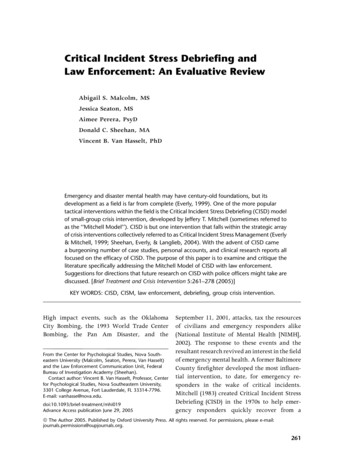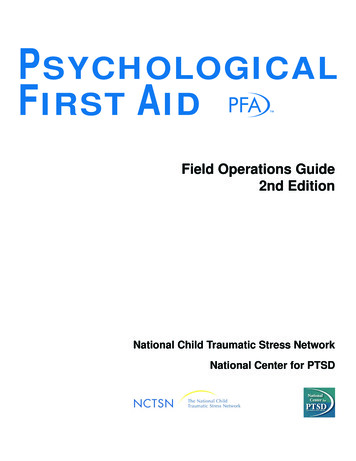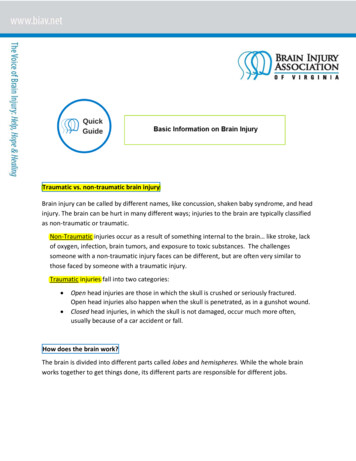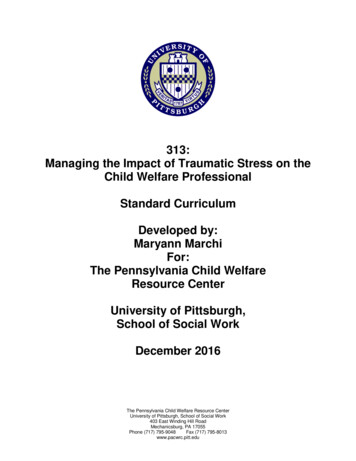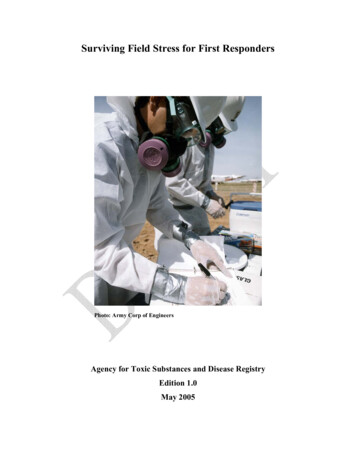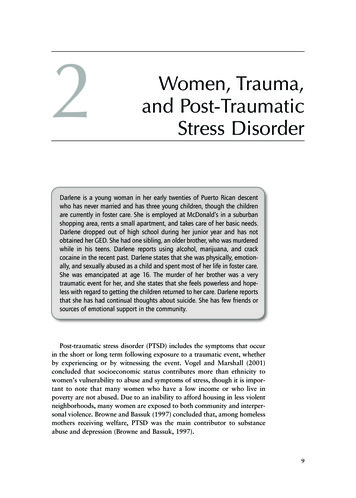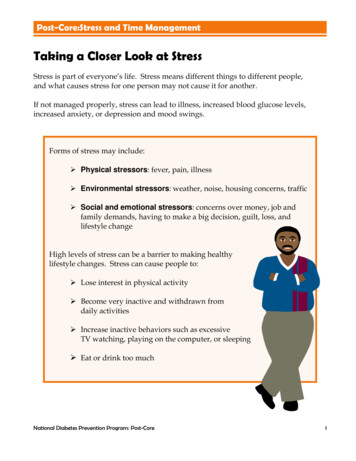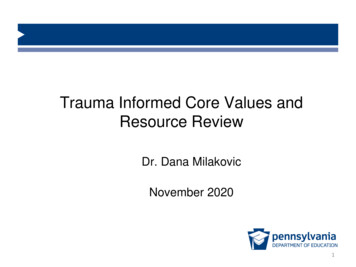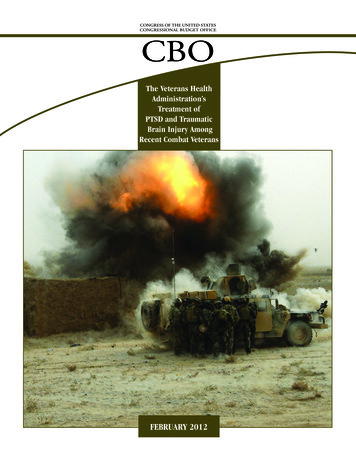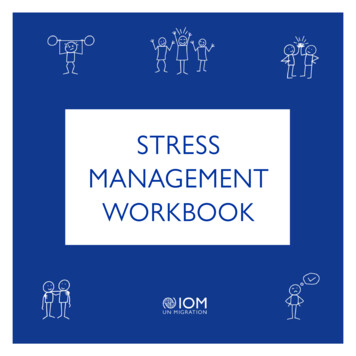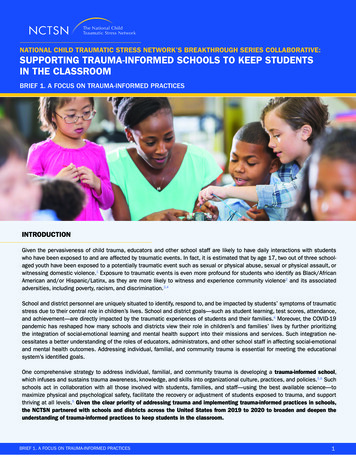
Transcription
NATIONAL CHILD TRAUMATIC STRESS NETWORK’S BREAKTHROUGH SERIES COLLABORATIVE:SUPPORTING TRAUMA-INFORMED SCHOOLS TO KEEP STUDENTSIN THE CLASSROOMBRIEF 1. A FOCUS ON TRAUMA-INFORMED PRACTICESINTRODUCTIONGiven the pervasiveness of child trauma, educators and other school staff are likely to have daily interactions with studentswho have been exposed to and are affected by traumatic events. In fact, it is estimated that by age 17, two out of three schoolaged youth have been exposed to a potentially traumatic event such as sexual or physical abuse, sexual or physical assault, orwitnessing domestic violence.1 Exposure to traumatic events is even more profound for students who identify as Black/AfricanAmerican and/or Hispanic/Latinx, as they are more likely to witness and experience community violence2 and its associatedadversities, including poverty, racism, and discrimination.3,4School and district personnel are uniquely situated to identify, respond to, and be impacted by students’ symptoms of traumaticstress due to their central role in children’s lives. School and district goals—such as student learning, test scores, attendance,and achievement—are directly impacted by the traumatic experiences of students and their families.4 Moreover, the COVID-19pandemic has reshaped how many schools and districts view their role in children’s and families’ lives by further prioritizingthe integration of social-emotional learning and mental health support into their missions and services. Such integration necessitates a better understanding of the roles of educators, administrators, and other school staff in affecting social-emotionaland mental health outcomes. Addressing individual, familial, and community trauma is essential for meeting the educationalsystem’s identified goals.One comprehensive strategy to address individual, familial, and community trauma is developing a trauma-informed school,which infuses and sustains trauma awareness, knowledge, and skills into organizational culture, practices, and policies.5,6 Suchschools act in collaboration with all those involved with students, families, and staff—using the best available science—tomaximize physical and psychological safety, facilitate the recovery or adjustment of students exposed to trauma, and supportthriving at all levels.5 Given the clear priority of addressing trauma and implementing trauma-informed practices in schools,the NCTSN partnered with schools and districts across the United States from 2019 to 2020 to broaden and deepen theunderstanding of trauma-informed practices to keep students in the classroom.BRIEF 1. A FOCUS ON TRAUMA-INFORMED PRACTICES1
Purpose of DocumentThis brief describes a number of promising trauma-informed practices that were tested andimplemented in five school- and district-based sites during the National Child Traumatic StressNetwork’s Breakthrough Series Collaborative: Supporting Trauma-Informed Schools to KeepStudents in the Classroom (hereafter referred to as the BSC or Collaborative). A breakthroughseries collaborative (BSC) is an established implementation and quality improvement methodology that supports the spread and sustainment of evidence-based practices.7 Any schoolor district can implement many trauma-informed practices; however, the discrete practicesfrom this BSC are not meant to be considered in isolation. Indeed, each practice tested withinclassrooms, schools, or districts occurred in the context of larger systems change, such asthe infusion of trauma awareness, knowledge, and skills into cultures, practices, and policies.Only in totality can the practices serve to create, support, and sustain a trauma-informedclassroom, school, or district.The data reported in this brief were taken from a variety of sources, including surveys administered after BSC Learning Sessions, in-person visits, notes from group calls, mixed-methodparticipant evaluations, and qualitative interviews and focus groups with BSC faculty andparticipants.Although this brief can be read byanyone, the strategies are intended to be used by the followingaudiences:1. Individual school personnel(e.g., paraprofessionals, teachers,school social workers, instructional coaches, vice principals)2. District-level administrators(e.g., directors of curriculum, superintendents)3. National Child Traumatic StressNetwork (NCTSN) centers andmembers partnering with schools4. Community mental and behavioral health partners5. Implementers of trauma-informed practices in schoolsBackground: Practice ImprovementsA core expectation in any BSC is that participating teams will test practice improvements to achieve the overall Collaborativemission. Practice improvements are change ideas, strategies, tools, processes, or policies that will significantly improveperformance when applied within a school or district.5 The mission of this BSC was specific to the implementation of trauma-informed practices that increase student time spent in the classroom.Six essential domains were developed and addressed as part of the Collaborative Change Framework (CCF) to translate thismission into action (Figure 1).6 Although these domains are interrelated and interconnected, for the purposes of the BSC,they were separated into distinct areas to organize teams’ implementation efforts into manageable pieces. The first domain(in red) forms the foundation for the other domains. The next three domains (in blue) center on the whole school, while thefinal two domains (in yellow) focus on what transpires in classrooms between school personnel and students. Together,these six domains outline the comprehensive strategy needed to develop, support, and sustain a trauma-informed schoolto ultimately keep students in theclassroom.Each domain is described in more detail below, along with thepractice improvements tested by participating teams. It is important to note that the intent of this BSC was not to focuson trauma-informed education practice, but practices specific toincreasing student time in the classroom. Regardless, a numberof teams went beyond this scope, as many practices that wereintended to positively impact time in the classroom were alsofound to positively impact general educational practices.Figure 1:Six essential elements addressed in the Collaborative Change Framework.BRIEF 1. A FOCUS ON TRAUMA-INFORMED PRACTICES2
Essential DomainsAt the completion of the BSC, participants were asked to identify the CCF domain they believed was the most essential tosupporting trauma-informed schools to keep students in the classroom.Overwhelmingly, 64.3% of participants identified Domain 1: Psychological and PhysicalSafety as the domain most essential to keeping students in the classroom.Participants also selected Domain 2: A Whole-School, Trauma-Informed School Climate(8.7%); Domain 3: Cultural Responsiveness, Racial Justice, and Authentic Inclusion(8.7%); and Domain 5: Trauma-Informed Learning Environment (4.3%) as essential.“I feel that no effective work inother areas can be sustainedif staff and students do notfeel safe.”-BSC ParticipantOther participants specified that it was difficult to select only one essential domain, as someof the content seemed to overlap. For example, one participant noted that COVID-19 illuminated how students and staff must feel psychologically safe for learning to occur, and thatracial unrest within his/her/their particular city brought forth hundreds of years of racismin the community. The participant added that, if ignored, racism would continue to threaten the physical and psychologicalsafety of students. Consequently, Domains 1 and 2 were viewed as interwoven and essential for trauma-informed school anddistrict change.Domain 1: Psychological and Physical SafetyENSURING EVERYONE IN SCHOOLS FEELS SAFE.Objective 1. Create and Promote a Safe School EnvironmentObjective 2. Promote Safety in Proactive WaysObjective 3. Embrace a Continuum of Trauma-Informed ResponsesOverviewDomain 1 provides a robust foundation for trauma-informed change, similar to Tier 1 of Multi-Tiered Systems of Support(MTSS).8 Within the context of the BSC, teams worked to create and support physically and psychologically safe school environments.Physical safety promotes an individual’s sense of bodily safety and physical integrity throughout the school and amongschool personnel, families, and students. Schools that promote physical safety prepare students for emergencies bypracticing safety drills, and maintain the condition of the property to prevent accidents.5Psychological safety refers to creating conditions that ensure that students and staff feel emotionally safe.5 Individuals with histories of trauma may associate certain people, places, or things with danger that may appear benign toothers. Consequently, these individuals often need specific interactions or conditionsto feel safe. This might mean having additional staff monitoring certain hallways, thedevelopment of a calm corner or classroom, consistent routines, or an environment“[My students] will never rethat prevents bullying with clear policies related to discipline.member my English class, butthey’re going to remember me.”-Audrey Fox, High SchoolTeacher, BSC ParticipantBRIEF 1. A FOCUS ON TRAUMA-INFORMED PRACTICES3
Practices to Test1. Mapping Hot Spots and Cool Zones: Teams completed a mapping activity for their specific school buildings to identify“hot spots” and “cool zones.” Hot spots are locations in which students experience frequent conflict, disciplinary issues,or trauma responses; while cool zones are areas that tend to be safe zones where conflict is minimal and students aregenerally calm.9 School staff used incident data and observations to determine the root causes of conflict and traumaticstress reactions in hot spots, and simultaneously examined characteristics of safe spaces for students and staff. Teamsthen actively enhanced physical and psychological safety, built relationships, and improved conflict-resolution skills in hotzones by implementing small, sustainable policy and practice changes. For example, some teams increased staffing in hotspots and made efforts to create space for discussions regarding what was working effectly in cool zones.2. Threshold Greetings: School staff began using threshold greetings (warm and intentional welcomes) when meetingstudents at entryways to the school or classroom. Staff described these greetings as brief check-ins, often acknowledging each student by name and/or allowing them to choose the type of greeting they would like that day (e.g., high-five, fistbump, eye contact).10 These greetings sought to: 1) establish a personal connection with students; and, 2) set and reinforce positive expectations before students entered a space.3. Calm Down Corners and Rooms: Calm down corners and rooms (also known as “safe spaces”) are designated areas tohelp students re-regulate when they are upset or distressed. These areas are inviting, comforting, and physically safe forstudents, separate from spaces used for consequences, and clearly identify coping strategies for students to use. Educators and other staff introduced the purpose of the calm down corners to students, helped them to understand when to usethe area, what coping skills to try, how long to use it, and how other students should treat peers when they are using thearea.Demonstration of PromiseEnhancing physical and psychological safety for students and staff can seem like an intimidating goal. With the support ofBSC faculty, teams generated and tried specific, targeted practices (e.g., threshold greetings, calm down corners), to quickly promote a safe school environment. One BSC participant noted, “I think we started out with a high focus on classroominterventions because we thought that would be our ‘easiest win’ – start with teachers who are ALREADY doing the work andgive them support and permission to really focus on those activities. But, in the end, it’s the practices that can be seen andfelt in the doorway, hallway, playground, and front office that are really having an impact.”BRIEF 1. A FOCUS ON TRAUMA-INFORMED PRACTICES4
Domain 2: A Whole-School, Trauma-Informed School ClimatePROMOTING POSITIVE SCHOOL CLIMATE AND A RESILIENT SCHOOL COMMUNITY.Objective 1. Support All Staff Wellness and ResilienceObjective 2. Promote and Support Individual and Collective ResilienceOverviewAn essential element of building a robust trauma-informed school climate is recognizing theimpact of trauma on students, staff, and the larger community. Domain 2 focuses on providing school personnel with the tools and skills to support, reinforce, deepen, and activateawareness of individual and organizational wellness. In other words, a trauma-informed schoolclimate promotes both self and organizational care (i.e., also known as “We-Care”).11 One wayto specifically promote staff wellness and resilience is to recognize and address burnout andsecondary traumatic stress (STS). STS is the emotional duress or distress that results whenan individual hears about the firsthand traumatic experiences of another.12 Any professionalwho works directly with children and families exposed to trauma—and is in a position to hearthe recounting of traumatic experiences—is at risk for STS. Within a trauma-informed schooland district, the development of STS is recognized as a common occupational hazard for staffworking with children and families.Practices to Test“Staff wellness was another[domain] that really rose up.So understanding the value ofbuying everybody donuts [wasimportant], but also looking atprofessional learning opportunities, guided book studies,one-on-one coaching; that’sall also part of staff wellness.And being really forthcomingwith the staff that it’s not theirjob to take care of themselves.It’s our job as a system to helpthem take care of themselves.”-BSC Participant1. School Climate Surveys: School climate surveys are common tools used by schools, counties, and states to comprehensively assess student engagement, the learning environment, and school safety.13 By measuring school climate, staff areprovided with the necessary data to identify school needs, set goals, and track progress toward improvement. Teams thatparticipated in the BSC used metrics and stories from school climate surveys to select trauma-informed tools and otherinnovations to create and sustain a supportive and professional environment.2. Address School Personnel STS and Wellness: From the beginning of the BSC, teams understood the importance of schoolpersonnel wellness. It became an undeniable focus throughout the course of the COVID-19 pandemic, which was concurrentto this BSC. Teams explored a number of wellness strategies to address STS and promote wellness including, but not limitedto, regular screening for burnout and STS, frequent school-level wellness activities (e.g., team building), peer support (e.g.,tap-outs), and stress management techniques (e.g., hand-to-heart). The Center on Children & Trauma has a helpful selectionof individual and organizational resources to support screening for and addressing STS at the individual and organizationallevels, many of which were shared during the BSC. Teams also learned about the importance of organizational care (“WeCare”), as compared to typical approaches in prescribing “self-care” to staff.3. Five-Minute Tap-Outs: In addition to awareness-building strategies for burnout and STS, teams articulated a need for practices to support teachers and other staff in managing in-the-moment stress and difficult student situations. Tap-outs allowedteachers and other staff to call on a peer when they needed to take a break for a few minutes—generally one to five minutes.Schools planned for tap-outs by identifying teachers with complementary schedules, or assigning leadership support for acertain period of the day. This short video from Edutopia is a simple yet helpful illustration of this strategy in practice.Demonstration of PromiseAlthough tools such as school climate surveys provide a snapshot of school and district needs, they often are performativeor transactional (i.e., checking a box), as compared to transformative (i.e., identifying priorities and changing practices). Bypairing surveys and change management supports with deep and authentic relationship building, schools and districts wereheld accountable for changing practices in meaningful and valuable ways. Indeed, one participant shared: “By creating a morewidespread trauma-informed school climate, the groundwork is laid for building the relationships necessary to support the otherdomains. It’s easier for both staff and students to make steps towards resiliency when the culture is supportive of individualand group efforts.”BRIEF 1. A FOCUS ON TRAUMA-INFORMED PRACTICES5
Domain 3: Cultural Responsiveness, Racial Justice, and Authentic InclusionCREATING AN ENVIRONMENT THAT IS AFFIRMING, RESPONSIVE, AND JUST.Objective 1. Promote Self- and Community-Level Awareness and ReflectionObjective 2. Recognize and Include Diversity in All Aspects of the SchoolObjective 3. Support and Reflect the Communities Being ServedObjective 4. Support a Culture that Promotes Racial JusticeOverview“Shifting our lens to see kids asA school or district cannot be trauma-informed without centering equitable and inclusivepart of a whole story instead ofpolicies and practices. As such, Domain 3 encourages schools to promote racial justicejust who they are when theyby reviewing practices and procedures that may adversely and disproportionately impactare in our building, helped to3specific groups of students and exacerbate traumatic stress reactions. Trauma-informedshift the climate of the school.”schools work to actively counteract the effects of historical trauma, societal oppression-BSC Participant(e.g., implicit and explicit bias), and systemic inequities in order to eliminate disparitiesin punitive and exclusionary (out-of-classroom or out-of-school) discipline practices. Schoolpersonnel also cultivate a strong foundation of healing and resilience by recognizing and promoting strengths-based social, cultural, and racial identities. Given that large-scale systemicchange takes time, trauma-informed schools encourage self- and community-level awareness and reflection. Establishingbrave spaces—or environments where all individuals are willing to take risks to engage with one another authentically—canbe an important first step to improving discourse and setting realistic goals to shift interpersonal dynamics among students,school personnel, and the community.Practices to Test1. District-Wide Trainings on Historical, Racial, and Systemic Trauma: To enhance knowledge and awareness about historical, racial, and systemic trauma, teams offered district-wide trainings to acknowledge the context, history, and manifestationsof historical and racial trauma within their communities. These trainings supported schools and districts in identifying andexamining systemic inequities, as well as selecting strategies to support school-wide values of cultural humility, diversity,equity, and inclusion.2. Community Conversations: In addition to district-wide awareness trainings, some teams prioritized cultivating relationshipsat all levels of the school (e.g., staff-student, staff-caregivers, staff-staff) to honor individual differences and demonstratethe value of racial and cultural inclusion. For example, a team located near a tribal nation partnered with tribal stakeholdersto integrate the nation’s cultural practices into the school environment. The team hosted focus groups to explore ways toincrease engagement with tribal caregivers, integrate tribal ritual items into calm down corners and rooms, and introducetraditional instruments into music curriculum.3. Disaggregate Data to Identify Disproportionate Practices: The disaggregation of data refers to the process of “breakingapart” data by specific student identifiers including, but not limited to, race, ethnicity, and gender.14 To identify disparities inthe use of disciplinary practices, teams collected office discipline referral (ODR) data—whether in a single classroom, blockof classrooms, or at the school level—by hand or using data management systems (e.g., SWIS). Data were disaggregated byrace and ethnicity and when disparate practices were identified, teams took steps to supportteachers and administrators in developing new practices and policies, such as implementing re- If your school or district is intereststorative circles.15 Several teams identified and addressed school staff behavior that was linked ed in learning more about addressto disparities such as over referral of Black and Indigenous male students to administration by ing racism and trauma specificallyin schools, this NCTSN guide outspecific staff members for discipline-related concerns.Demonstration of Promiselines specific recommendationsfor school personnel and offers alist of supplemental resources.During the BSC, teams were impacted by two intersecting pandemics, or a syndemic:16 COVID-19and racial unrest. With respect to data demonstrating disparities, one BSC participant noted:“The numbers show[ed] that we had a lot of room to grow in this area. We had some pretty heartbreaking, disproportionate discipline data that we knew we had to address. Disproportionate to students with disabilities, disproportionate to students of color.And I don’t think anyone felt really good about the way things were going.” If used effectively, ODR data can be an importantanalytic tool to better identify needs and tailor support strategies to specific teachers, classrooms, and/or schools.BRIEF 1. A FOCUS ON TRAUMA-INFORMED PRACTICES6
Domain 4: Active Child, Youth, Family, and Community PartnershipREACHING OUT, INCLUDING, ENGAGING, AND SUPPORTING ACTIVE PARTNERSHIPS.Objective 1. Partner with Students, Families, and Communities in Student Specific DecisionsObjective 2. Partner with Students, Families, and Communities in School-Level DecisionsOverviewIndividual and community traumas involve experiences of powerlessness and isolation that can contribute to students andfamilies feeling less likely to trust school personnel, authority figures, and educational institutions.4 Domain 4 emphasizesengagement and partnership with students, families, and the community to co-create policies, protocols, and guidelinesrelated to trauma-informed classrooms and schools, as well as to authentically partner with students and their families indiscussions and decisions related to education, school engagement, and discipline. Indeed, research suggests that whenstudent engagement increases, academic achievement improves.17 Co-creation also leads to relevant and culturally responsive innovations desired by communities and feasible to sustain.18 It is important to remember that co-creation requiresthe establishment of trust. Trust is generally not built through sweeping gesturesor decisions but through everyday interactions in which students, families, andcommunities feel seen, heard, and valued. In other words, change occurs at the Example: Making Time to Connect“[Our school] engaged more families on multispeed of trust.18Practices to Test1. Frequent Parent Meetings: A trauma-informed approach acknowledges thatcaregivers are experts when it comes to their children. Some teams partnered withcaregivers through frequent parent meetings (e.g., parent-teacher conferences),during which caregivers were encouraged to highlight their children’s strengths,and any additional supports needed within the home, school, or community environments. Increased caregiver involvement in the school also influenced schoolled decisions and a cultural shift that promoted school personnel-caregiver partnerships.ple levels by having things like virtual orientation. You know, we had the option as a teachingteam to set that up anyway we wanted. And wecould have just done one orientation and beendone with it. But we decided to take the time tohave separate orientations for each grade leveland even each homeroom.We ended up doing about seven meetings altogether with smaller groups of students, ratherthan having just one big orientation that we justinvited everyone to where we couldn’t really answer specific questions, or we couldn’t take thetime to go carefully through all of our studentsand [connect with] them on an individual level.”2. Use of Technology: In response to restrictions associated with COVID-19, teamsused technology in innovative and inclusive ways. Some teams offered multiple-BSC Participantvirtual orientations at the level of the homeroom, grade, and school (see call-outbox for additional details). In contrast, others conducted virtual parent-teacherconferences allowing for more flexibility and 100% parental participation in someclassrooms. To increase caregiver participation, many teams began texting families 24-48 hours before scheduled meetingsand events, or announcing events through social media, enhancing trust through simple, everyday interactions.3. Family Resource Center: In consultation with families, one team actively reached out and partnered with community organizations to develop a comprehensive system of support that addressed family needs. Specifically, this team recognized theprevalence of food insecurity within the community and built a food bank in the school so that students and families couldaccess much-needed resources.Demonstration of PromiseAs part of the BSC, teams were encouraged to identify caregivers open to partnering and championing change in their children’s schools. Of all six domains, teams noted that changes within Domain 4 were often the most difficult to implement.However, small, iterative practices like virtual orientations, reminder texts, or connecting with a particular student can help toestablish trusting relationships among students, families, communities, and schools.BRIEF 1. A FOCUS ON TRAUMA-INFORMED PRACTICES7
Domain 5: Trauma-Informed Learning EnvironmentSUPPORTING A CLASSROOM ENVIRONMENT THAT NURTURESACHIEVEMENT, BEHAVIOR, COPING, DEVELOPMENT, AND RELATIONSHIPS (ABCD-R).Objective 1. Maintain Consistent, Predictable, Stable, Effective Routines and RelationshipsObjective 2. Promote Student Resilience, Wellness, and Social SkillsObjective 3. Promote Positive Interactions Between and Among StudentsOverviewStudents’ traumatic stress reactions may manifest as disruptive behaviors (e.g., interrupting, distracting others, not followingteacher instructions, emotional outbursts, aggression). These stress reactions may keep students out of their classroomsdue to office referrals, visits to the nurse’s office, suspensions, and even expulsions.6 Not only do these removals limitacademic achievement, but they also impact students’ abilities to grow socially and emotionally. In other words, traumaticstress reactions and their subsequent effects impact students’ ABCD-R: Achievement, Behavior, Coping, Development, andRelationships.6 Domain 5 nurtures ABCD-R through practices that create predictable and supportive learning environments.By teaching and modeling emotional expression, as well as self- and co-regulation, trauma-informed schools support students’ capacity to build emotional intelligence, strengthen developmentally appropriate social skills, and cultivate positiverelationships.19,20,21Practices to Test1. Social Contracts: A social contract is an agreement created by students and teachers with shared behavioral expectations, norms, and values.22 Contracts differ from traditional classroom rules and consequences in that students are involvedin co-creating and designing the agreements (consistent with the partnership described in Domain 4). Behavioral expectations are stated in positives or language that encourages prosocial and collaborative behavior (e.g., “be honest” vs. “don’tlie”). Teams created social contracts at the start of the year to build positive and trauma-informed classroom cultures, andintegrated these values into classroom activities like group discussions. Teams solidified expectations by regularly reflectingon the social contract—whether on a daily or weekly basis. Please visit this Edutopia link for an illustration of this practice.2. Social Emotional Learning (SEL): SEL is defined as “the process through which all young people and adults acquire andapply the knowledge, skills, and attitudes to develop healthy identities, manage emotions and achieve personal and collective goals, feel empathy towards others, establish and maintain supportive relationships, and make responsible and caringdecisions.”19 Although there are many curricula to support SEL implementation in schools, one team found RULER—anevidence-based approach to SEL developed at the Yale Center for Emotional Intelligence—to be particularly helpful.20 Thisapproach began with staff training, later extending to student-oriented classroom instruction and family education and engagement.3. Freshman Academies: High school-level teams described freshman academies as an effective program to facilitate andnurture supportive relationships as students transition from middle to high school. Although every freshman academy operates differently, such programs are generally characterized as small learning communities within large high schools thatprovide individualized support for ninth graders to establish a more intimate community. Specifically, one team described howits freshman academy generated a handful of motivational videos for incoming ninth graders.Demonstration of PromiseAlthough SEL interventions have improved academic performance and classroom behavior, managing traumatic stress reactions can be a challenge, even with the most robust SEL program.19 One BSC participant reflected, “When a kid is still hidingunder the desk, or still eloping from the classroom, or still coming in late every day, teachers, rightfully so, feel exhausted. [Teachers think], ‘
Network's Breakthrough Series Collaborative: Supporting Trauma-Informed Schools to Keep Students in the Classroom (hereafter referred to as the BSC or Collaborative). A breakthrough series collaborative (BSC) is an established implementation and quality improvement meth-
